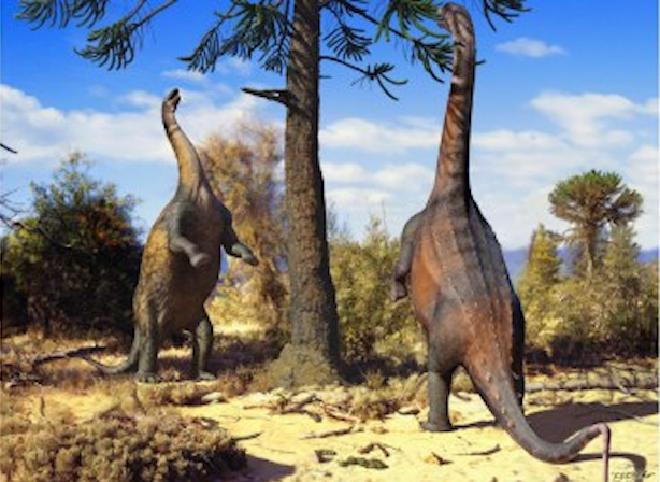

Sixty-six million years ago, two genera of long-necked, quadrupedal dinosaurs had an advantage over other sauropods: they could easily stand on their hind legs for extended periods. This allowed them to scare off potential predators and feed on leaves high up in trees, for example.
The scientists used a computational technique adopted in engineering. They aimed to estimate the stress on the femur caused by gravity and the weight of the sauropods when standing on their two hind legs.
“Smaller sauropods like these had a bone and muscle structure that allowed them to stand more easily and for longer on their two hind legs. Larger ones were probably also able to stand, but for a shorter time and with less comfort, since the position caused a lot of stress on the femur,” summarized Julian Silva Júnior, a postdoctoral researcher at the School of Engineering of São Paulo State University (FEIS-UNESP) in Ilha Solteira, Brazil. Silva Júnior is the first author of the study, which was conducted during an internship at the University of Tübingen in Germany with a scholarship from FAPESP.
South Americans #
The simulations were performed using finite element analysis (FEA), a computational technique that simulates how materials behave under conditions such as force and heat. This technique is widely used in bridge design, for example.
“Using this technique, we performed two simulations. One dealt with the extrinsic scenario, simulating the force coming from outside to inside. In this case, gravity and the animal’s own weight on the femur when the dinosaur was standing on its hind legs. In the other, we analyzed the intrinsic scenario, the force that the muscles would exert on the femur,” Silva Júnior explained.
“They had more robust femurs and could dissipate stress better. The bigger ones had very large muscles and even giant femurs, but not enough to support their weight. That doesn’t mean they couldn’t stand up, but they probably chose the best time to do so, because it must have been an uncomfortable position,” said the paleontologist. He pointed out that adult Uberabatitan individuals, unlike the juvenile analyzed in the study, would probably have had the same difficulty standing on their hind legs as other giant species.
The position would have been useful for feeding and reaching food in the highest parts of trees since sauropods were leaf eaters. It may also have been used for reproduction, allowing males to mount females and perform displays to attract mates. Finally, it may have been useful for defense, making them appear larger to potential predators.
Furthermore, since cartilage was not examined in any of the seven specimens, it is assumed that its role was similar in all of them. “The tool we use is very efficient for comparisons, even if the answer isn’t exact for each one. By comparing representatives from different lineages, we can get a fairly accurate picture of how these animals behaved millions of years ago,” concluded Silva Júnior.
Citation #
- The study Standing giants: a digital biomechanical model for bipedal postures in sauropod dinosaurs was published in Palaeontology journal. Authors: Julian C. G. Silva Junior, Gabriel S. Ferreira, Agustín G. Martinelli, Thiago S. Marinho & Felipe C. Montefeltro.
Funding #
-
Conselho Nacional de Desenvolvimento Científico e Tecnológico
-
Fundação de Amparo à Pesquisa do Estado de São Paulo. Grant Number: 2024/01597-5
Article funding #
The Article Processing Charge for the publication of this research was funded by the Coordenação de Aperfeiçoamento de Pessoal de Nível Superior - Brasil (CAPES) (ROR identifier: 00x0ma614).
Contact [Notaspampeanas](mailto: notaspampeanas@gmail.com)

